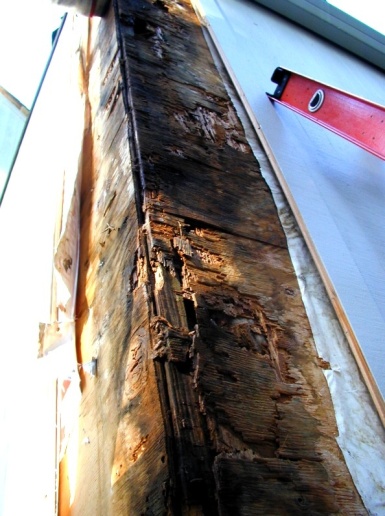We repair windows and doors damaged by water leaks. Click here to view some of our water remediation projects, or scroll down to learn some valuable maintenance tips that will help you avoid future water damage.
Water Leaks
We specialize in water leak forensics. We correct the faulty Flashing and/or Moisture-Barrier and/or Glazing issues that allow most water leaks to occur. And then if needed, we repair the damage caused by the leaks resulting in dry rot, wet rot or mold. We’re experts at Water Damage Restoration Service.
- Rotten Siding
- Rotten Plywood Sheathing
- Rotten Structural Wall Components
- Rotten Window Sash, Jambs, Sills, Trim
- Rotten Door Sash, Jambs, Sills, Exterior Moulding
View Defect/Water Remediation Projects We’ve Completed
We offer well over two decades of expertise in:
- Water Damage Restoration Service
- Fixing Water Leaks
- Rot Repair
- Mold Removal
In our experience, about 98% of all water leaks are related to improperly applied Flashing, Moisture Barrier or Failed Glazing and lack of maintenance.
Leaks are very rarely related to a problem with the quality of a window or door assembly.
Although the installation, or more specifically, the improper flashing of the window while being installed is often proven to be one of the leading culprits.
Proper Flashing Technique & Application is NOT Rocket Science. Indeed, it pertains to the simplest of principles.
“That which is above must sufficiently overlap that which is below to protect all exterior seams.”
Thus, keeping all water to the exterior of the structural envelope.
When structural or architectural designs limit or prevent overlap, then augmenting with products such as metal flashing materials (Example; Z-Flashing) must be employed to create an adequate overlap to prevent water penetration.
Flashing Mistake #1
Believing that caulking is a sufficient last line of defense against water intrusion into your walls.
Flashing Mistake #2
Thinking that the gap between the top of your windows and the siding needs to be caulked and that the gap is probably the source of the leak that is showing up at the interior top of your window.
Flashing Mistake #3
Cutting off the nailing-fins when installing windows to save on labor (not having to cut back the siding) to win a larger percentage of the bids.
Flashing Mistake #4
Using low-end moisture barrier materials.
We are often asked why the wood windows of the past 30 years or so seem to rot so much easier than the much older wood windows.
We’ve identified three likely reasons:
The quality of the wood used. Old-growth tight-grain vs. trees harvested much younger.
Wood windows were coated with lead until 1978.
Some of the popular architectural designs of the day forgo the use of eaves and awnings that used to protect window and door openings.
Maintenance Tip #1
Wood Window and Door Components that get wet almost every time it rains must be protected!
If awnings or storm-doors/windows are not an option, then the seams of the intersecting wood-components should be checked, caulked if needed & the products painted on an annual or semiannual basis.
Maintenance Tip#2
Even Aluminum-Clad WOOD window or door components should be checked every year or two for glazing that has begun to fail and aluminum-miters that are opening up.
That is, unless you don’t mind the cost and hassle of eventually repairing or replacing some of your windows and doors.
View Defect/Water Remediation Projects We’ve Completed
Please contact for an estimate to repair your water damage, or to arrange inspection services.
Note:
Inspecting your windows and doors every year or two is among the many services we offer!
What a coincidence!
No, seriously. This is an important part of “protecting” what is arguably among the most important financial investments most folks will ever make in their lives.
Their house or commercial properties.
If you knew how many thousands of dollars homeowners spend in OR and WA every year repairing rotten windows, doors, and exterior walls, you might quickly agree that the $400.00 to $600.00 you’d spend on an annual or semiannual inspection to protect your investment is among the smartest maintenance money you could spend on your property. You’ll receive written reports for your records—a great benefit when you go to sell your house. Because it’s preventative maintenance!
There are sometimes conflicting opinions regarding the merits of repairing rotten windows and doors. In large part, we believe that this is because there are some companies who employ questionable repair practices, such as butt-jointing spliced components and leaving portions of the original wood components that have already been affected by the spread of the rot inducing fungus, thus translating into additional rot to the repaired door or window, a year or two down the road.
We inspect rotting and previously repaired doors and windows almost every day, so we know that there are many “previously repaired” wood doors and windows with components that have continued to degrade.
And to be fair, discerning the extent to which fungus has already affected adjoining wood components is less than an exact science.
Nonetheless, there are certain common-sense practices that can minimize the potential for missing infected wood components.






